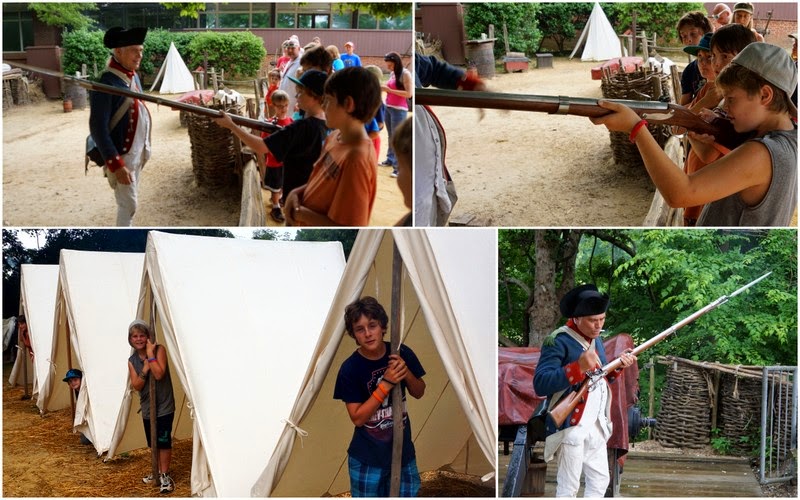
The State of Virginia has also opened a new museum called the Jamestown Settlement. There were people dressed in period costume and a recreation of the village with houses, a church, replicas of the ships the settlers came on and the government building.
We had lunch before we went on to Yorktown.
Yorktown is where the final decisive battle of the Revolutionary War was fought. The French Fleet cut Cornwallis (for the English) off from supplies that were arriving by sea. Eventually he had to surrender because he was out of ammunition and food.
At Yorktown there was a good introductory film and then we went into the encampment to see how the soldiers lived and worked. There were small pup tents for the ordinary soldiers, 6 men to a tent. It was a very tight squeeze and if one got sick all 6 got sick. The captain or general had a larger tent with a small table, cot and a place for his little portable "desk".
The soldiers on duty demonstrated the firing of a cannon and also how to fire a musket. We learned the difference between a musket and a rifle. As the cannon demonstration progressed there began to be thunder and lightening and we all had to go into the museum building for our safety.
While we were in the museum we watched a demonstration of some of the medical techniques used in the day and we got to examine some of the medical tools that were used--pliers and foreceps to remove shot from legs and arms, or to pull out a rotten tooth, saws and rods to cut off limbs and cauterize them. None of it looked like something we would like to experience. There were also some samples of the herbs and bark that were used for medicine.
Once we were able to go outside again we saw the wash woman's area with her price list for washing the soldiers clothes--2cents for socks and 5 cents for a shirt and a kitchen with an example of the soldiers rations--a pound of salted meat and a cup of beans and some hardtack. There was a big mound next to the kitchen tent and several small holes dug into the mound. This is where the soldiers would put some logs and then they would put their pot on top of the dirt over the burning logs and cook up their communal pot of bean and meat stew. Each tent had a space to cook their rations and they usually chose one man to be the cook because after the group experienced the cooking of each member they chose the best cook.
There was also an example of a farm with a small one-room farm house where a family of 6 or 7 would live, and an extensive garden with all kinds of vegetables and berries and fruits. Tobacco was a very important crop for early settlers, so there was a field of tobacco growing and a curing shed with real tobacco hanging from the rafters.
After all of this exploring it was back to the condo for a swim and dinner and off to bed early because we have to get up at 4am tomorrow.








Sounds like a hard way to live. Boys look like they are enjoying themselves.
ReplyDelete